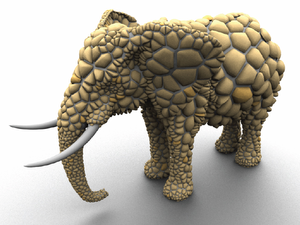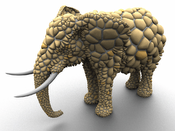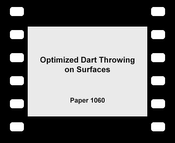Information
- Publication Type: Journal Paper with Conference Talk
- Workgroup(s)/Project(s): not specified
- Date: June 2009
- Journal: Computer Graphics Forum
- Volume: 28
- Number: 4
- Location: Girona
- Lecturer: David Cline
- Event: EGSR
- Pages: 1217 – 1226
Abstract
In this paper we present dart throwing algorithms to generate maximal Poisson disk point sets directly on 3D surfaces. We optimize dart throwing by efficiently excluding areas of the domain that are already covered by existing darts. In the case of triangle meshes, our algorithm shows dramatic speed improvement over comparable sampling methods. The simplicity of our basic algorithm naturally extends to the sampling of other surface types, including spheres, NURBS, subdivision surfaces, and implicits. We further extend the method to handle variable density points, and the placement of arbitrary ellipsoids without overlap. Finally, we demonstrate how to adapt our algorithm to work with geodesic instead of Euclidean distance. Applications for our method include fur modeling, the placement of mosaic tiles and polygon remeshing.Additional Files and Images
Additional images and videos
Additional files
Weblinks
No further information available.BibTeX
@article{cline-09-poisson,
title = "Dart Throwing on Surfaces",
author = "David Cline and Stefan Jeschke and Anshuman Razdan and
Kenric White and Peter Wonka",
year = "2009",
abstract = "In this paper we present dart throwing algorithms to
generate maximal Poisson disk point sets directly on 3D
surfaces. We optimize dart throwing by efficiently excluding
areas of the domain that are already covered by existing
darts. In the case of triangle meshes, our algorithm shows
dramatic speed improvement over comparable sampling methods.
The simplicity of our basic algorithm naturally extends to
the sampling of other surface types, including spheres,
NURBS, subdivision surfaces, and implicits. We further
extend the method to handle variable density points, and the
placement of arbitrary ellipsoids without overlap. Finally,
we demonstrate how to adapt our algorithm to work with
geodesic instead of Euclidean distance. Applications for our
method include fur modeling, the placement of mosaic tiles
and polygon remeshing.",
month = jun,
journal = "Computer Graphics Forum",
volume = "28",
number = "4",
pages = "1217--1226",
URL = "https://www.cg.tuwien.ac.at/research/publications/2009/cline-09-poisson/",
}


 paper
paper video
video

